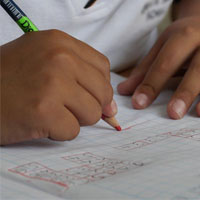What Does Dyslexia Look Like in Children?

What Does Dyslexia Look Like in Preschool and Primary School?
 Dyslexia can be identified at any point from preschool right into adulthood, and a diagnosis can be very helpful even if it’s given later in life. It’s generally easier to pin down a diagnosis for a child than for an adult, and getting the support they need early on can be very beneficial to a child’s development.
Dyslexia can be identified at any point from preschool right into adulthood, and a diagnosis can be very helpful even if it’s given later in life. It’s generally easier to pin down a diagnosis for a child than for an adult, and getting the support they need early on can be very beneficial to a child’s development.
From person to person, the symptoms and indicators of dyslexia can be completely different. A unique pattern of strengths and weaknesses can be found in each person who has the condition.
In this article, we’ll look at some of the signs of dyslexia that you might see in different age groups. If your child shows a number of the indicators mentioned, it may be worth looking into getting a diagnosis.
Early Identification Checklist
Your child might have some or all of these difficulties in preschool if they have dyslexia. Many of these indicators are common in all children for a while. However, if your child hasn’t grown out of these issues by the time the majority of their peers have it could be a sign that additional support is needed.
Weaknesses
- Is there a history of learning difficulties in your family?
- Does your child’s preschool teacher often complain that they aren’t making an effort or listening in class?
- Does your child often get confused between colour names (e.g. calling yellow blue)?
- Does your child have difficulty putting things in order (e.g. the alphabet, numbers, days of the week)?
- Is your child able to follow instructions (e.g. sort bricks by size)?
- Does your child find thinking of words and labelling things difficult?
- Can they play games like catching, Simon says and hopping?
- Does your child struggle to speak clearly, not speak at all or speak with a lisp?
- Does your child show no interest in books, but still enjoys listening to stories?
- Can they clap a rhythm back to you?
- Are they able to pick the odd word out from lists (e.g. dog, fog, cat, bog)?
- Does your child tend to hold pens and pencils too tightly?
- Does your child tend to confuse directions (e.g. up/down and left/right)?
- Does your child trip over and knock things down a lot?
- Does your child have difficulties putting shoes on the right feet, tying laces, buttons or getting dressed?
Many of the signs of dyslexia at preschool age are speech-and sound-related. Speech problems, such as jumbling up phrases and not being able to pronounce long words (saying “beddy tear” instead of “teddy bear”, or “abmulance” instead of “ambulance”) are common, and many will have difficulty understanding the idea of rhyming words and nursery rhymes like “the frog sat on the log”.
Many preschool-age children with dyslexia will have difficulty expressing themselves in spoken language and will put sentences together incorrectly or struggle to think of the right word.
Strengths
A preschooler with dyslexia may also have a number of unique strengths. For example…
- Is your child very quick-minded, with lots of original ideas?
- Does your child struggle with minor tasks but seem intelligent overall?
- Are they good at arts and crafts?
- Is your child particularly good at construction games such as building, keyboards, remote controls and LEGO?
Children in School
 When children start school and begin to focus on learning how to write and read, their dyslexia symptoms generally become more easily recognisable.
When children start school and begin to focus on learning how to write and read, their dyslexia symptoms generally become more easily recognisable.
Children aged 5 to 12 who have dyslexia might show signs such as…
- Difficulty remembering the sound and name of each letter.
- Writing “b” as “d” or “6” as “9” (drawing them the wrong way around).
- Making errors when reading aloud, or taking a long time to read something.
- Having difficulty writing answers down, but being able to answer them orally.
- Writing slowly.
- Taking longer than normal to complete written work, and struggling to copy written text.
- Poor phonological awareness and word attack skills.
- Poor handwriting.
- Difficulty carrying out a sequence of directions.
- Describing letters and words as seeming to move around or appear blurred (visual disturbances).
- Confusing the order of letters in words.
- Spelling that’s unpredictable and inconsistent.
Writing
- Does your child continue struggling with these things, even after correction?
- Uncertain if they are left- or right-handed?
- Struggle to write in a straight line despite margins and guiding lines?
- Leave out capital letters or put them in the wrong places?
- Leave out paragraphs and punctuation, or use them in the wrong places?
- Forget to cross ‘t’s and dot ‘i’s?
Phonics
The ability to understand that words are made up of smaller sound units (phonemes) and that manipulating or replacing phonemes can create new meanings and words is known as “phonological awareness”.
These questions will be challenging for children with dyslexia who have poor phonological awareness:
- What sounds are used to make the word “cot”? What sounds are used to make the word “cat”? Are they different?
- Can you list some words that rhyme with “dog”?
- What word would you have if you changed the “d” sound in “pod” to a “t” sound?
Other Signs and Symptoms
- Is your child easily distracted, or do they struggle to concentrate?
- Is your child able to read a clock?
- Can your child follow multiple instructions at the same time?
- Are maths symbols like multiply and add difficult for them?
- Is your child a “late bloomer”?
- Do they tend to use either their right or left eyes/hands in certain tasks (this is called mixed laterality)?
- Do they have an inability to use telephone directories and thesauruses?
- Does your child have problems with their short term memory when it comes to instructions and written phrases?
- Does your child struggle with sequences such as nursery rhymes, numbers in tables, months of the year, days of the week?

For more information about dyslexia, check out Need2Know’s Essential Guide to Dyslexia which takes you step-by-step through diagnosis, treatment, education and into career options. Need2Know also have some great books about Asperger’s Syndrome, and ADHD . Whether you’re a student, a teacher or a parent, we have all the information you need!




